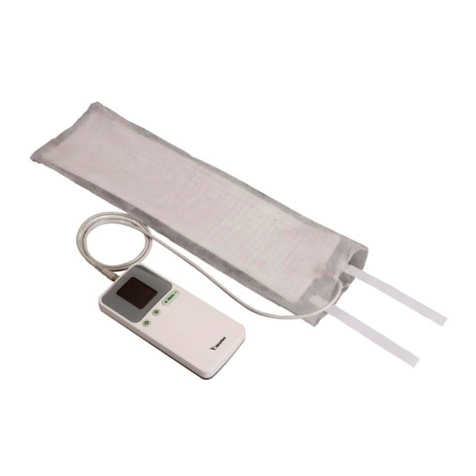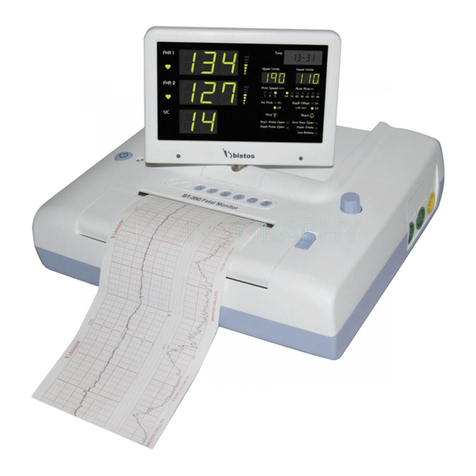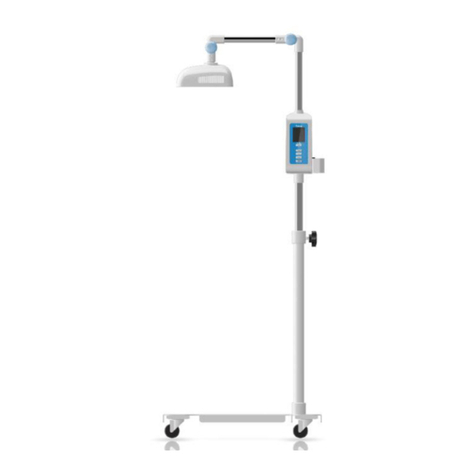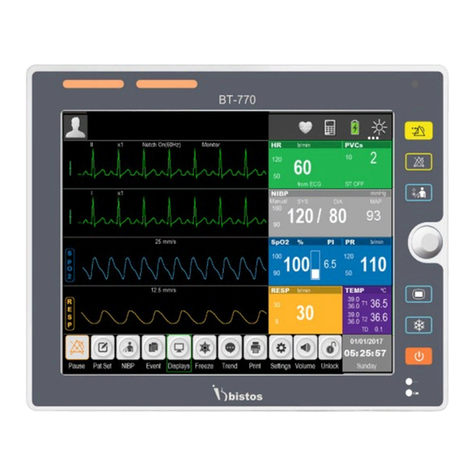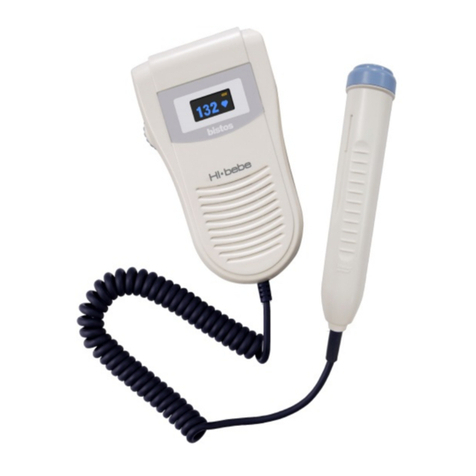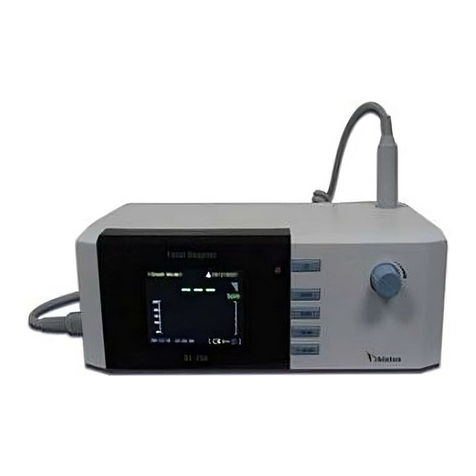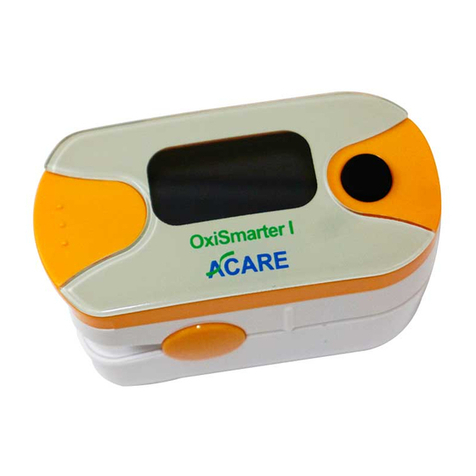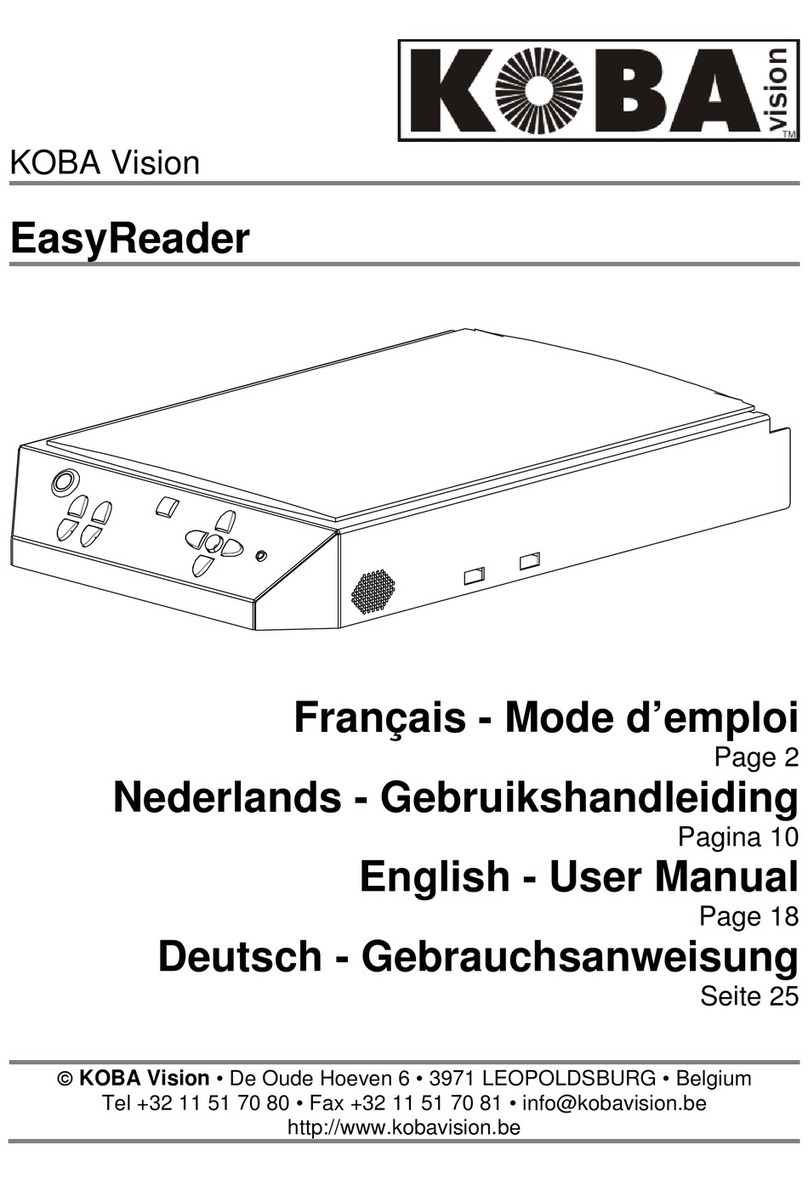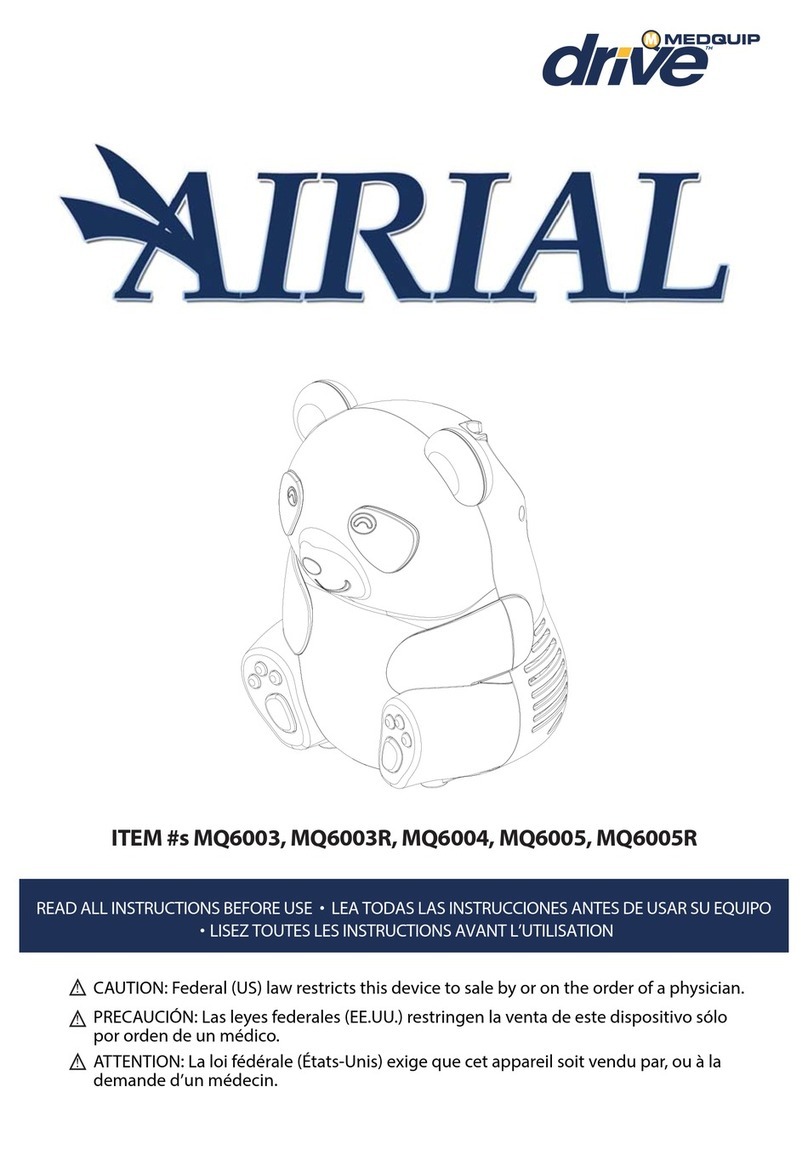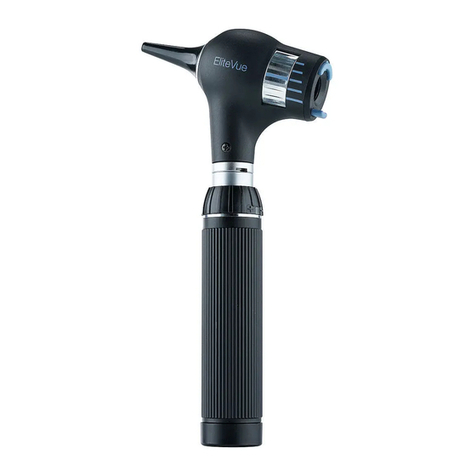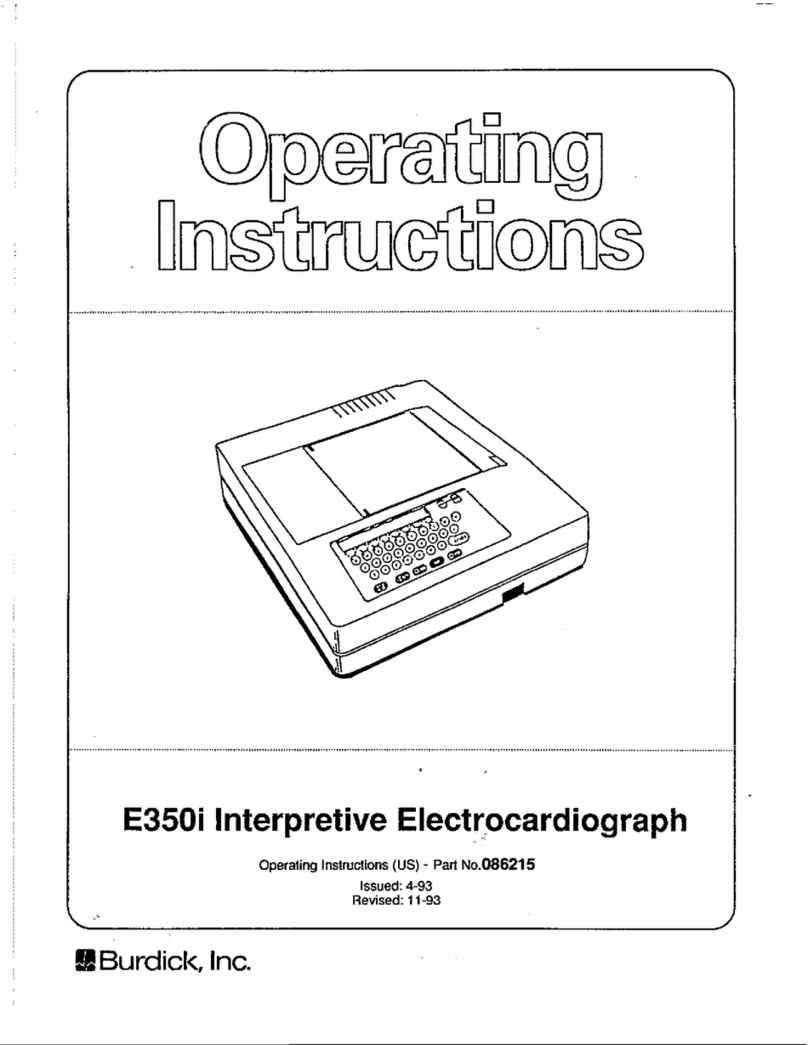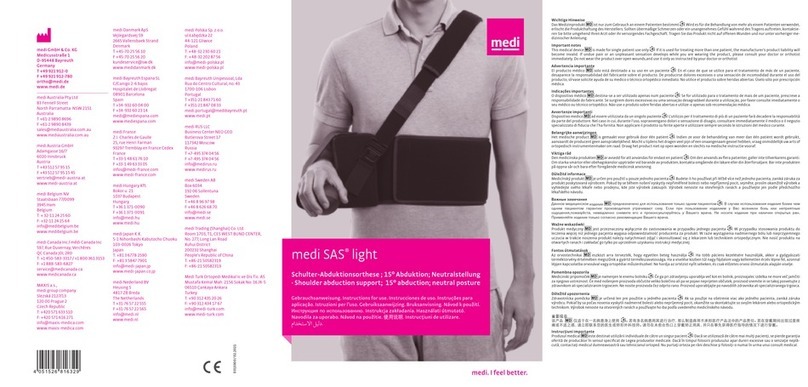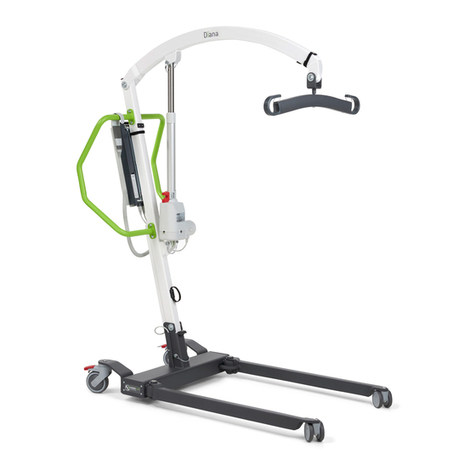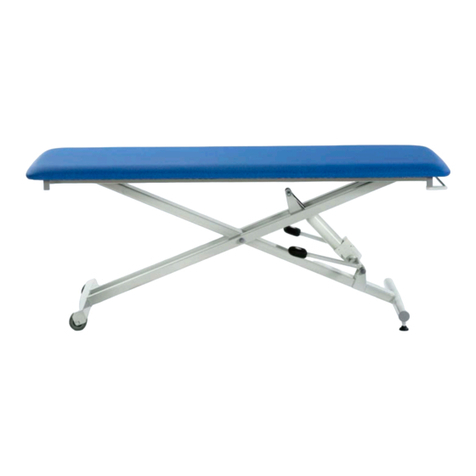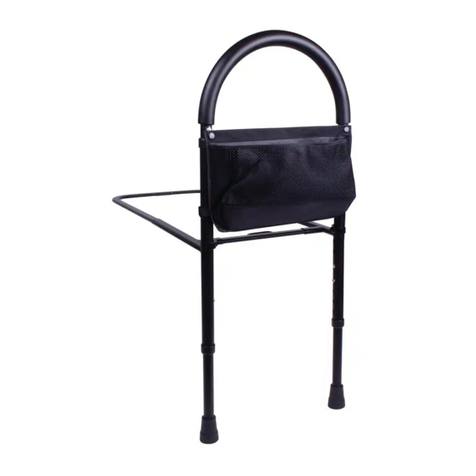Bistos BT-720 User manual

BT-720 Patient monitor
Operation Manual
Keep this manual for future reference
P/N : 720-ENG-OPM-EUR-R03

BT-720 Operation manual
P/N:720-ENG-OPM-ENG-R03 Bistos Co., Ltd. 2020.10
1
Proprietary Material
Information and descriptions contained in this manual are the property of Bistos Co., Ltd. and may
not be copied, reproduced, disseminated, or distributed without express written permission from
Bistos Co., Ltd.
Information furnished by Bistos Co., Ltd is believed to be accurate and reliable. However, no
responsibility is assumed by Bistos for its use, or any infringements of patents or other rights of third
parties that may result from its use. No license is granted by implication or otherwise under any patent
or patent rights of Bistos Co., Ltd.
The information contained herein is subjects to change without notice.
Prepared by:
Bistos Co., Ltd.
7th FL., A Bldg., Woolim Lions Valley 5-cha,
302, Galmachi-ro, Jungwon-gu, Seongnam-si,
Gyeonggi-do, Korea
Telephone: +82 31 750 0340
Fax: +82 31 750 0344
Revision R03
October, 2020
Printed in Korea
Copyright © Bistos Corporation 2018. All rights reserved.

BT-720 Operation manual
P/N:720-ENG-OPM-ENG-R03 Bistos Co., Ltd. 2020.10
2
Contents
0. Safety information --------------------------------------------------------------------------4
0.1 General precautions, warnings and cautions --------------------------------------5
0.2 Shock hazards -----------------------------------------------------------------------------7
0.3 Battery warnings -------------------------------------------------------------------------8
0.4 General precautions on environment -----------------------------------------------9
1. System basics -------------------------------------------------------------------------------9
1.1 Intended use ------------------------------------------------------------------------------10
1.2 Operating principle ----------------------------------------------------------------------10
1.3 System configurations ------------------------------------------------------------------10
1.4 Product outlook --------------------------------------------------------------------------11
1.5 Description of monitor -----------------------------------------------------------------11
1.6 Understanding the display ------------------------------------------------------------12
1.7 Essential performance ------------------------------------------------------------------13
2. Preparing for operation ------------------------------------------------------------------13
2.1 Installation --------------------------------------------------------------------------------13
2.2 Connecting to power -------------------------------------------------------------------14
3. Basic operations ---------------------------------------------------------------------------14
3.1 Turn on -------------------------------------------------------------------------------------14
3.2 Turn off ------------------------------------------------------------------------------------15
4. Setup the monitor -------------------------------------------------------------------------15
5. SpO2-------------------------------------------------------------------------------------------17
5.1 Overview -----------------------------------------------------------------------------------17
5.2 Safety information ----------------------------------------------------------------------17
5.3 Monitoring steps -------------------------------------------------------------------------18
5.4 Setting SpO2 -------------------------------------------------------------------------------------------------------------------------18
5.5 Measuring influencing factor ---------------------------------------------------------19
5.6 Technical description -------------------------------------------------------------------19
6. NIBP -------------------------------------------------------------------------------------------19
6.1 Overview ----------------------------------------------------------------------------------19
6.2 Safety information ----------------------------------------------------------------------20
6.3 Measurement limits --------------------------------------------------------------------21
6.4 Measurement procedure --------------------------------------------------------------21
6.5 Setting NIBP -------------------------------------------------------------------------------22
6.6 Clean and disinfection method of NIBP cuff --------------------------------------23
7. Review ----------------------------------------------------------------------------------------24
8. Alarm ------------------------------------------------------------------------------------------25
9. Battery ----------------------------------------------------------------------------------------26
9.1 Overview -----------------------------------------------------------------------------------26
9.2 Battery usage guide ---------------------------------------------------------------------26
9.3 Checking battery performance -------------------------------------------------------27
9.4 Battery recycling -------------------------------------------------------------------------27

BT-720 Operation manual
P/N:720-ENG-OPM-ENG-R03 Bistos Co., Ltd. 2020.10
3
10. Caring and cleaning -----------------------------------------------------------------------27
10.1 Overview ---------------------------------------------------------------------------------27
10.2 Cleaning ----------------------------------------------------------------------------------27
10.3 Disinfection ------------------------------------------------------------------------------28
11. Maintenance --------------------------------------------------------------------------------28
11.1 Checking ----------------------------------------------------------------------------------28
11.2 Maintenance plan ----------------------------------------------------------------------29
12. Accessories --------------------------------------------------------------------------------- 29
13. Specifications -------------------------------------------------------------------------------30
13.1 Safety specification --------------------------------------------------------------------30
13.2 Hardware specifications --------------------------------------------------------------30
13.3 Functional specification --------------------------------------------------------------31
14. Common faults and maintenance -----------------------------------------------------32
15. Manufacturer’s declaration on EMC -------------------------------------------------33
15.1 Electromagnetic emissions ----------------------------------------------------------33
15.2 Recommended separation distances between portable and mobile RF communications
equipment and BT-720 -----------------------------------------------3 4
15.3 Electromagnetic immunity ----------------------------------------------------------35
Product Warranty --------------------------------------------------------------------------------37

BT-720 Operation manual
P/N:720-ENG-OPM-ENG-R03 Bistos Co., Ltd. 2020.10
4
0 Safety information
Before using BT-720 Patient monitor, read this entire manual and be fully understood the following
safety information to prevent injury of patient and user.
Symbols Used
The following symbols identify all instructions that are important to safety. Failure to follow these
instructions can lead to injury or damage to the patient monitor. When used in conjunction with the
following words, the symbols indicate:
WARNING
Can lead to serious injury or death.
CAUTION
Can lead to minor injury or product/property damage
The following symbols are placed on product, label, packaging and this manual in order to stand for
the information about:
Used to identify safety information.
Be well-known this information thoroughly before using BT-720.
Used to identify safety information.
Be well-known this information thoroughly before using BT-720
IPX1
Indicates the protection level against the ingress of liquid.
IPX1 is protection against some water drops falling vertically.
It correspond the device, patient monitor.
IPX2
Indicates the protection level against the ingress of liquid.
IPX2 is protection from some water drops when the device is tilted up to
and including 15°.
It correspond the accessories for SpO2.
Refer to operation manual. Read manual before placing the device.
Indicates DC power supply.
Indicates the device is in the battery operation mode.
Indicates nurse call interface.
Indicates network interface.
Indicates USB interface.
Indicates power adapter polarity.
Indicates the production date.
Indicates the manufacturer.
Indicates the serial number of the device.
Indicates the authorized representative in the European Community of
manufacturer.
Indicates a defibrillation-proof type BF applied part.
Indicates a defibrillation-proof type CF applied part.
Indicates CLASS II equipment.(Adapter)
Indicates the date after which the medical device is not to be used.

BT-720 Operation manual
P/N:720-ENG-OPM-ENG-R03 Bistos Co., Ltd. 2020.10
5
Indicates to keep the device dry.
Indicates the medical device that can be broken or damaged if not handled
carefully.
Indicates to keep upright
Indicates the maximum stacking limit.
Indicates the temperature limitation for operation, transport and storage.
Indicates the humidity limitation for operation, transport and storage.
Indicates the range of atmospheric pressure to which the medical device
can be safely exposed.
Indicates the device contains natural rubber latex.(Accessories)
Indicates the packing material is recyclable.
Indicates to not dispose the device together with unsorted municipal
waste(for EU only). The solid bar symbol indicates that mains adapter is
put on the market after 13 August 2005.
0.1 General precautions, warnings and cautions
•Examine the patient monitor and any accessories periodically to ensure that the cables,
adapter cords and instruments do not have visible evidence of damage that may affect
patient safety or performance. The recommended inspection interval is once per week or
less. Do not use the patient monitor if there is any visible sign of damage.
•Only the DC power adapter supplied with the BT-720 is approved for use with the device.
•Do not attempt to service the BT-720 patient monitor. Only qualified service personnel by
Bistos Co. Ltd. should attempt any needed internal servicing.
•Perform periodic safety testing to insure proper patient safety. This should include
leakage current measurement and insulation testing. The recommended testing interval is
once per year.
•If the hospital or healthcare institutions using this device fail to implement a satisfactory
maintenance schedule, it will result in device failure and may endanger the patient’s
safety.
•Use the patient monitor under the conditions specified in this operation manual. Beyond
the conditions, the patient monitor may not function properly and the measurement
results may not accurate and may result in device failure or endangering the patient’s
safety.
•Do not operate the BT-720 patient monitor if it fails to pass the power on self-test
procedure.
•During the operation, do not disconnect any cable.
•The BT-720 patient monitor is intended to be used by clinical professionals or trained
doctors, nurses or laboratory assistant.
•Do not service and maintain or clean the device including accessories while in use with a
patient.
•Using the device to one patient at a time.

BT-720 Operation manual
P/N:720-ENG-OPM-ENG-R03 Bistos Co., Ltd. 2020.10
6
WARNING
•Thoroughly read and understand the manual prior to use of the BT-720. Failure to
do so could result in personal injury or equipment damage.
•The device is intended for clinical patient monitoring, and only trained and
qualified doctors and nurses should use the device.
•The alarm volume, upper and lower alarm limits should be set according to the
actual situation of the using environment. Do not just rely on audio alarm system
while monitoring the patient, because too low alarm volume or muted alarm may
result in notice failure of alarm situation and endanger the patient’s safety. Please
pay close attention to the actual clinical status of the patient.
•Use only the power adapter supplied with monitor.
•Position the monitor where it is easy to de-energize the monitor when needed.
•Do not open the enclosure to avoid an electric shock. Any repair and upgrade of
monitor should be done by service personnel trained and authorized by Bistos. Co.,
Ltd.
•When handling packaging materials, abide by local laws and regulations or hospital
waste disposal regulations. Keep the packaging materials away from children.
•Do not use in the presence of flammable anesthetics to prevent explosion or fire.
•Install the power lines and cables of accessories carefully to avoid patient
entanglement or suffocation, cables tangled or electrical interference.
•When the monitor is used together with electrosurgical devices, the user (a doctor
or a nurse) should ensure the safety of the patient and instrument.
•The physiological wave, physiological parameters and alarm information displayed
on the monitor are only for the doctor’s reference and should not be directly used
as the basis for clinical treatment.
•This is not a therapeutic device.
•For patients with pacemakers, the cardio tachometer may count the pacemaker
pulse in case of a cardiac arrest or arrhythmias. Never rely solely on the cardio
tachometer alarm. Closely monitor the patients with pacemaker. For the inhibition
of the device on pacemaker, refers to this manual.
•Use of accessories other than those listed and approved for use with this product
may result in increased emissions or decreased immunity.
•Medical electrical equipment needs special precautions regarding EMC and needs
to be installed and put into service according to the EMC information provided in
this manual. In addition, portable and mobile RF communications equipment can
affect medical electrical equipment.
•The equipment shall not be used adjacent to other devices unless verification of
normal operation in the configuration in which it is to be used can be achieved.
•Keep matches, and all other sources of ignition, out of the room in which the
patient monitor is located. Textiles, oils, and other combustibles are easily ignited
and burn with great intensity in air enriched with oxygen. Personal injury or
equipment damage could occur.
•A fire and explosion hazard exists when performing cleaning or maintenance
procedures in an oxygen-enriched environment.
•The patient monitor has been validated with the accessories and options listed in
this manual and found to comply with all relevant safety and performance
requirements applicable to the device. It is therefore the responsibility of the
person or organization who makes an unauthorized modification, or incorporates
an unapproved attachment to the device.
•
An operator may only perform maintenance procedures specifically described in

BT-720 Operation manual
P/N:720-ENG-OPM-ENG-R03 Bistos Co., Ltd. 2020.10
7
this manual.
•Do not remove the covers of a BT-720 yourself to avoid damage to the equipment
and unexpected electrical shock. Only qualified Bistos service engineer must repair
or replace components.
CAUTION
•
Please install or carry the instrument properly to prevent damage due to falling,
collision, strong vibration or other mechanical force.
•Avoid instrument splashed by water.
•Avoid high temperatures, the instrument should be used within a temperature
range of 5 ℃~ 40 ℃。
•Avoid using instrument in the environment such as pressure is too high, poor
ventilation, dusty, or contain salt, sulfur gas and chemical.
•Before using the monitor, check the monitor and accessories if there is damage
that may affect patient safety. If there is obvious damage or aging, replace the
parts before use. The replacement should be made with same parts of original
parts.
•Before powering on the device, make sure that the power used by the device
complies with the supply voltage and frequency requirements on the equipment
label or in the Operator’s Manual.
•Equipment should be tested at least once a year, the test should be done and
recorded by trained, have security testing knowledge and experienced personnel.
If there are any problems in the tests, they must be repaired.
•When the instrument and accessories are about to exceed the useful life
(expected service life: 5 years), it must be treated in accordance with relevant
local laws and regulations or the hospital's rules and regulations.
•Do not connect to other equipment or network which not specified in the
instruction for use, in risk of external high voltage.
•Do not connect any equipment or accessories that are not approved by the
manufacturer or according to IEC 60601-1 to the monitor. The operation or use of
non-approved equipment or accessories with the monitor is not tested or
supported, and monitor operation and safety are not guaranteed in such a case.
•Any non-medical equipment (such as the external printer) is not allowed to be
used within the patient vicinity (1.5m/6ft.).
•Parts and accessories used must meet the requirements of the applicable safety
standards, and/or the system configuration must meet the requirements of the
medical electrical systems standard.
•Ensure that the conductive parts of electrodes and associated connectors,
including neutral electrodes, do not come in contact with earth or any other
conducting objects.
•Protection of ME EQUIPMENT against effects of discharge of a cardiac defibrillator
depends on use of proper cables.
0.2 Shock hazards
WARNING
Unplug the monitor from its power source prior to cleaning or maintenance to prevent
personal injury or equipment damage.
Some chemical cleaning agents may be conductive and leave a residue that may permit
a build-up of conductive dust or dirt. Do not allow cleaning agents to contact electrical

BT-720 Operation manual
P/N:720-ENG-OPM-ENG-R03 Bistos Co., Ltd. 2020.10
8
components and do not spray cleaning solutions onto any of these surfaces. Personal
injury or equipment damage could occur.
Do not expose the unit to excessive moisture that would allow for liquid pooling.
Personal injury or equipment damage could occur.
Do not touch the patient and signal input/output parts simultaneously
Due to the risk of electrical shock hazard, only qualified personnel with appropriate
service documentation should service the monitor.
0.3 Battery warnings
WARNING
Improper operation may cause the internal lithium ion battery to be hot, ignited or
exploded, and it may lead to the decrease of the battery capacity. It is necessary to read
the operation manual carefully and pay more attention to warning message.
Do not open the battery compartment. Only the qualified service personnel authorized
by the manufacturer can open the battery compartment and replace the battery, and
batteries of same model and specification should be replaced.
Be careful when connecting the battery with polarity.
Do not use the battery near fire or environmental temperature exceeds 60 ℃. Do not
heat or splash the battery or throw it into fire or water.
Do not destroy the battery. Do not pierce battery with a sharp object such as a needle.
Do not hit with a hammer, step on or throw or drop the battery. Do not disassemble or
modify the battery. The battery can heat, smoke, deformation or burning.
When leakage or foul smell is found, stop using the battery immediately. If your skin or
cloth comes into contact with leaked liquid, cleanse it with clean water at once. If the
leaked liquid splashes into your eyes, do not wipe them. Irrigate them with clean water
first and go to see a doctor immediately.
Properly dispose of or recycle the depleted battery according to local regulations.
0.4 General precautions on environment
Do not keep or operate the equipment under the environment listed below.
Avoid placing in an area exposed
to moisture. Do not touch the
equipment with wet hand.
Avoid exposure to direct
sunlight
Avoid placing in an area where
high variation of temperature
exists. Operating temperature
ranges from 5℃~ 40℃.
Operating humidity ranges from
30 % ~ 85 %.
Avoid in the vicinity of
electric heater.
Avoid placing in an area where
there is an excessive humidity
rise or ventilation problem.
Avoid placing in an area
where there is an excessive
shock or vibration.
Avoid placing in an area where
chemicals are stored or where
there is in danger of gas leakage.
Avoid dust and especially
metal material enter into
the equipment
Do not disjoint or disassemble
the device. Bistos Co., Ltd. does
not have liability of it.
Power off when the
equipment is not fully
ready to operate.
Otherwise, the equipment
could be damaged.

BT-720 Operation manual
P/N:720-ENG-OPM-ENG-R03 Bistos Co., Ltd. 2020.10
9
1 System basics
1.1 Intended use
The BT-720 Patient Monitors acquire the physiological signals for non-invasive blood pressure (NIBP),
pulse rate (PR) and blood oxygen saturation (SpO2). The signals are converted into digital data and
processed, examines the data for alarm conditions and display the data. The monitor also provides
operating control for the user. The patient monitor intend to use in hospital clinical area such as
intensive care units, operating room, emergency department, to provide additional information to the
medical and nursing staff about the physiological condition of the patient. The BT-720 patient monitors
are intended to be used only under regular supervision of clinical personnel. It is suitable for adult and
pediatric, neonate. The intended locations of use are hospitals and clinics.
1) Intended patient population
-Adult (>18 years adults) and Pediatrics (30 days < and <18 years) and Neonate (0 days<
and <30days)
2) Intended user profile
-Doctor, physicians or nursing staff who is qualified personnel
-Basic experiences or knowledge on medical field, especially on patient monitoring
-Trained or requested to read IFU before use
3) Environment of use
-Hospital and clinic
-Requirements: Stable power source
4) Scope of application
This monitor is suitable for bedside monitoring of patient. This monitor enables blood oxygen
saturation (SpO2), pulse rate (PR) and monitoring. It is equipped with a replaceable built-in battery to
provide convenience for the patient movement in hospital.
5) Indications and contraindications
Blood oxygen saturation (SpO2)
Indication:
- Monitoring effectives of oxygen therapy
- A reading is needed to facilitate the completion of an early warning score to
inform clinical assessment
- Sedation or anesthesia
- Transport of patients who are unwell and require oxygenation assessment
- Haemodynamic instability (e.g. cardiac failure or Myocardial Infarction)
- Respiratory illness e.g. asthma, chronic obstructive pulmonary disease
- Monitoring during administration of respiratory depressant drugs, e.g. opiate
epidural or patient-controlled analgesia.
- Assessing oxygen saturation during physical activity e.g.
in pulmonary
rehabilitation
Contraindications
- Pulse oximetry does not give an indication of haemoglobin so if the patient is
profoundly anaemic then their oxygen saturation may by normal but they may still
be hypoxic
Source: NHS. “Clinical Procedure_ Procedure for Pulse Oximetry/SPO2”. Wirral Community NHS
Trust. Sep, 2013
Non-invasive blood pressure (NIBP)
Indication:
- To determine a patient’s blood pressure
- Screen for hypertension
- Following the effect of anti-hypertensive treatments in a patient to optimize their
management
- Assessing a person’s suitability for a spot or certain occupations

BT-720 Operation manual
P/N:720-ENG-OPM-ENG-R03 Bistos Co., Ltd. 2020.10
10
- Estimation of cardiovascular risk
- Determining for the risk of various medical procedure
- Figuring out whether a patient is clinically deteriorating or is at risk.
Contraindications
- Oscillometric blood pressure devices may not be accurate in patients with weak or
thready pulse
- In patients with heart beats below 50 beats/minutes, even if the rhythm is regular,
some of the semi-automatic devices are unable to reduce their deflation rate
sufficiently so that too rapid a falling in cuff pressure results in underestimation of
systolic blood pressure and overestimation of diastolic blood pressure.
- Do not apply to limb with AV fistula, significant injury or burn, or lymph node
removal post mastectomy.
Source: [1] NHS. “Clinical Procedure_ Procedure for Blood Pressure Monitoring”. Wirral
Community NHS Trust. Dec, 2013
[2] Clinical Quality& Patient Safety Unit, QAS. Clinical Practice Procedures:
Assessment/Non-invasive blood pressure
. Queensland Government, 2016.
https://www.ambulance.qld.gov.au/clinical.html
1.2 Operating principle
Refer to the chapters for every physiological parameter from chapter 5 to chapter 6.
1.3 System configurations
Basic configuration of BT-720
•Main body with 4.3” touch screen and built-in lithium-ion battery
•Adult SpO2 probe and extension cable
•AC/DC adapter
Options of BT-720
•Non-invasive blood pressure cuff
Picture
Name
Description
Qty
Adult SpO2 sensor
(standard) SpO2 sensor for adult 1ea
SpO2extension cord
(Standard)
Cord to connect the SpO2 sensor
and main body 1ea
Adult NIBP cuff
(Option) Measures NIBP for adult 1ea
NIBP extension tube
(Option)
Tube to connect the NIBP cuff and
main body 1ea
Adapter
(Standard) For power supply 1ea

BT-720 Operation manual
P/N:720-ENG-OPM-ENG-R03 Bistos Co., Ltd. 2020.10
11
1.4 Product outlook
Figure1-1: Front view
Figure1-2 : Rear view
1.5 Description of monitor
Figure1-3: Front view
Name
Description
1 NIBP
NIBP tube interface. This is option. When you purchase the monitor
only with SpO2, this interface will be blocked.
2
SpO2
SpO2 cable interface
3
Display area
Display the waveform and measured value
4 Alarm indicator
Indicates the priority of physiological alarm and technical alarms in
different colors and flashing frequencies.
-High priority: Red, fast flashing (1.4 ~ 2.8 Hz)
-Medium priority: Yellow, slow flashing (0.4 ~ 0.8 Hz)
-Low priority: Yellow, constant on
5
[Setting]
Enter to the setting mode. Press again to close the setting mode.
6
[NIBP]
Start and stop the non-
invasive blood pressure measurement manually.
This is option. When you purchase only with SpO2 this button will be
deleted.
7
[Alarm reset]
To reset the alarm condition.

BT-720 Operation manual
P/N:720-ENG-OPM-ENG-R03 Bistos Co., Ltd. 2020.10
12
8
DC power
indicator Turned on when the monitor is being powered by the adapter.
9
Battery indicator
-On: The battery is being charged or has been fully charged.
-Off: The battery has not been installed.
-Flashing: The monitor is being powered by the battery.
10
[Power]
-Power On: Press down the key more than 2 seconds.
-Power Off: Press down the keys more than 2 seconds and the
system will display the alarm message “The system will shut down
3 seconds”.
Figure1-4: Rear view
Name
Description
1
Network port
For CMS
2 Type A USB For software upgrade
3
Type B USB
Reserved for data transfer
4
Power adapter
15V, 2.4A adapter
1.6 Understanding the display
Figure 1-5: Standard display
Description
1
Current alarm message. When an alarm occurs, this area will displayed yellow or white
depending on the alarm type.
2
SpO2value. Display the measured SpO2value.
3
SpO2upper alarm limit. Display the user set upper alarm limit
4
SpO2waveform. Display the measured SpO2waveform.
5
SpO2lower alarm limit. Display the user set lower alarm limit

BT-720 Operation manual
P/N:720-ENG-OPM-ENG-R03 Bistos Co., Ltd. 2020.10
13
6
Perfusion Index. Display the measured perfusion index.
7
Sweep speed. Display the user set SpO2waveform speed.
8
RTIP. Display the current measured cuff pressure value.
9
MAP. Display the average pressure value.
10
Diastolic blood pressure value.
11
Systolic blood pressure value.
12
The unit of NIBP.
13
Battery status.
14
Patient type.
15
Display current time.
16
The unit of SpO2.
1.7 Essential performance
This device Patient Monitor provides various patient vital signs such as pulse rate, blood oxygen
saturation and non-invasive blood pressure by placing the sensors to the appropriate site of patient.
The device is composed with display, control circuit and panel, and input part for various sensors. It
detects SpO2, PR and NIBP using specific sensors and cuff. The detected analog signal amplifies and
converted to digital. This concerted data feed to the CPU and converted to the display format as
number and waveform. This device is incorporated with alarm system. The alarm generated when the
detected signal range is beyond the user set alarm limits.
2 Preparing for operations
2.1 Installation
To ensure normal working of the monitor, read this chapter before use, and install as required.
WARNING
All analog and digital devices connected to the monitor must be certified by IEC
standards (e.g. IEC 60950 Data processing equipment standard and IEC 60601-1 Medical
equipment standard). Furthermore, all configurations shall comply with valid version of
IEC 60601-1 standard. The personnel connecting additional devices to the input / output
signal ports are responsible for the compliance with IEC 60601-1 standard. If there is any
question, please contact Bistos.
If the patient cable interface and network interface are connected with multiple devices,
the total electric leakage current cannot exceed the allowable value.
The copyright of monitor software belongs to Bistos
. Without permission, any
organization or individual shall not interpolate, copy or exchange by any means or form.
When the monitor is combined with other devices, it must comply with IEC 60601-
1:2005 + A1:2012, and should not be connected with multi-socket outlet or extension
cord.
Do not connect the device on other equipment or network, to w
hich a signal
input/output part may be connected.
Prior to installation, the operator must ensure that the following space, power, environmental
requirements are met.
2.1.1 Unpack and check
BT-720 patient monitor was inspected rigorously at the factory before delivery, in order to avoid being
hit when transported, carried out careful packaging. Before unpacking, carefully inspect the package. If
any damage, please immediately contact the Bistos. Unpack in the correct way, carefully remove the
monitor and accessories from the box and check with the packing list. Check if there is any mechanical
damage, the all listed are completely packed. If you have questions, please contact the marketing
department of Bistos or agency.
Please keep the packing box and materials for use in future transporting or storage.

BT-720 Operation manual
P/N:720-ENG-OPM-ENG-R03 Bistos Co., Ltd. 2020.10
14
2.1.2 Placement requirements
Equipment installation must meet:
-Ensure that the operating floor and the monitor have enough space for connecting the
accessory wires.
2.1.3 Power requirements
-DC power supply adapter
Input: A.C. 100 V ~ 240 V, 50/60 Hz
Output: D.C. 15 V, 2.5 A
-Built-in rechargeable lithium-ion battery: D.C. 11.1 V, 4400 mAh
2.1.4 Environmental requirements
The storage, transport and use of the monitor must meet the following environmental requirements.
Operating
environment
Ambient temperature
5
℃
~ 40
℃
Relative humidity
30 % ~ 85 % (Non-condensing)
Atmospheric pressure
700 ~ 1060 mbar (hPa)
Transportation
Prevent severe shock, vibration, rain and snow splashing during transport.
Storage
The packaged monitor should be stored in well-ventilated room with
ambient temperature -20 ℃~ 60℃, relative humidity 0 ~ 95 % (Non-
condensing), atmospheric pressure 700 ~ 1060 mbar(hPa), and without
corrosive gases.
The operating environment of the monitor should avoid noise, vibration, dust, corrosive or flammable
and explosive materials. In order to allow air flowing smoothly and achieve good heat dissipation, at
least 2 inches (5cm) clearance should be kept around the device.
When the device is moved from one environment to another, the device may have condensation due
to the differences in temperature or humidity. In this case, wait until the condensation disappears
before using the device.
WARNING
Ensure that the monitor is used under specified environment. Fail to do this, the
technical specifications declared in this manual may not be met and it may result in
damage to equipment and other unforeseen consequences.
2.2 Connecting to power
WARNING
Do not try to open the monitor when the power is connecting.
During the operation, do not disconnect any cable.
Connect to power adapter in the following steps:
-Make sure that the AC power supply meets the following specifications: a.c.100V-240V,
50/60Hz.
-Use the power adapter provided with the monitor. Plug the power adapter into the
power connector of the monitor, and plug the other end of the power adapter into the
mains (low voltage power supply network facilities) power outlet.
3 Basic operations
3.1 Turn on
3.1.1 Check the monitor
-Before turn on the monitor, check whether there is mechanical damage to the monitor, and
whether the external cables and accessories are connected correctly.
-Plug the power adapter into the AC power outlet. If using battery power, make sure the battery
is fully charged.
-Check all the functions required for patient monitoring to make sure that the monitor operates
properly.

BT-720 Operation manual
P/N:720-ENG-OPM-ENG-R03 Bistos Co., Ltd. 2020.10
15
WARNING
If the monitor is damaged, or fails to work normally, do not use it for patient monitoring.
Please contact the maintenance personnel or Bistos immediately.
3.1.2 Start the monitor
If finish to check the monitor, it is ready to start the monitor.
Press the [Power] key and the system enters the main interface within seconds.
-If any fatal error occurs during self-test, the system will alarm. If this case persists, please
stop to using the monitor and contact the maintenance personnel or Bistos.
-Check all available monitor functions to ensure that the monitor operate properly.
-If the monitor equipped with a battery, charge the battery after each use to ensure
sufficient power.
-After unpacking, when use the monitor first time, the monitor should be powered with
adapter.
3.1.3 Connect the sensors
Connect the required sensor to the monitor and the monitoring site of patient.
3.1.4 Start monitoring
Start monitoring in the following steps:
-Check if the patient cable and the sensor are connected properly.
-Check if the settings of the monitor are corrects, such as patient type.
-For the details of parameter measurement or monitoring, see the appropriate section.
-The operator can operate according to their own habits, standing in front, left or right of
the monitor, easy to observe and operate the monitor.
3.2 Turn off
Turn off the monitor in the following steps
-Disconnect the cables and sensors connected to the patient.
-Press and hold the [Power] key for 2 seconds to pop up the 3 seconds countdown
window, and the monitor turns off in 3 seconds.
CAUTION
•If the monitor is not turned off properly, you can simply disconnect the power to
shutdown forcibly. But the forced shutdown may cause data loss, and it is not
recommended.
4 Setup the monitor
In the main screen, Press the [Setting] key enter the setup menu.
Select “Patient Type”, you can choose “Adult” or “Pediatric” or “Neonate”.
Select “Alarm Delay”, you can choose off, 1s, 2s, 3s, 4s, 45s, 5s, 6s, 7s or 8s.
Select “Alarm Volume”, and enter value(Range: 0-9).

BT-720 Operation manual
P/N:720-ENG-OPM-ENG-R03 Bistos Co., Ltd. 2020.10
16
Select “Backlight”, and enter value(Range: 0-5), 5 is the brightest.
Select “Alarm Reminder Signal”, you can choose “On”, or “Off”.
Select “Alarm Reminder Interval”, you can choose “1min”, “2min”or “3min”.
Select “Date Format”, and set the date format in accordance with custom
“YYYY-MM-DD”: Year- Month-Day.
“MM-DD-YYYY”: Month -Day-Yea r.
“DD-MM-YYYY”: Day-Month-Yea r.
“Date (YMD)”: Set the year, month, and day.
“Time (24H)”: Set the hour, minute and second.
Select “Screen Setup”, set “SpO2+NIBP”.
Select “Language”, and select the option as needed:
“English”: The interface language of the monitor is English.
“Türkçe”: The interface language of the pulse oximeter is Turkish.
“Español”: The interface language of the pulse oximeter is Spanish.
“Français”: The interface language of the pulse oximeter is French.
“Polski”: The interface language of the pulse oximeter is Polish.
“Italiano”: The interface language of the monitor is Italian.
“Deutsch”: The interface language of the monitor is German.
“Magyar”: The interface language of the monitor is Hungary.
“Portuguese”: The interface language of the monitor is Portugal.
Select “Network”, you can choose “On”, or “Off”.
Select “Default”, back to the initial state.
Select “Network Setup”, set up the network.
Select “Passwords”, set Passwords.
Select “SpO2”, set “S-089”.

BT-720 Operation manual
P/N:720-ENG-OPM-ENG-R03 Bistos Co., Ltd. 2020.10
17
5 SpO2
5.1 Overview
Blood oxygen saturation (SpO2) is the percentage of oxyhemoglobin (HbO2) capacity bound by oxygen
in the blood in the total hemoglobin (Hb) capacity that can be combined, that is, the concentration of
oxygen in the blood.
The principle for monitoring the pulse SpO2is to fix the probe fingerstall on the patient’s finger or toe,
use the finger (or toe) as a transparent container for hemoglobin, use 660nm wavelength red light and
950nm near-infrared light as the incident light, maximum output power is 300 mW, measure the light
transmission intensity through the tissue bed, and calculate the concentration of hemoglobin and SpO2.
The passing lights depend on a variety of factors, most of which are constant. However, one of these
factors, the arterial blood flow, changes with time, as it is pulsating. By measuring the light absorbed
during pulsating, it is possible to obtain the arterial blood SpO2. Detection pulsation can give a
“plethysmography” wave and pulse rate signal.
The main screen displays “SpO2” value and “plethysmography” wave.
This monitor applies to measure SpO2of adults (>18 years) and pediatric (<18 years,>30 days),
neonate (<30 days). Contact SpO2probe to Patient’s finger (or toe) to get “SpO2” value and
“plethysmography” wave.
SpO2function of this monitor has been calibrated in factory.
The monitor is defibrillation proof, so the monitor operates normally after defibrillation.
5.2 Safety information
WARNING
Please use SpO2 sensor supplied from Bistos, operate in accordance with the Manual,
and observe all warnings and precautions.
Before monitoring, check whether the sensor cable is normal. When SpO2sensor cable is
unplugged from the socket, the screen will display “SpO2 Sensor Off” error message,
and trigger an audible and visual alarm simultaneously.
If the sensor or sensor packaging has signs of damage, do not use this SpO2sensor;
return it to the manufacturer.
If there is carboxyhemoglobin, methemoglobin or dye diluted chemical, the SpO2value
will have deviation.
When the patient has a tendency to hypoxia, use the oximeter to analyze blood samples
in order to fully grasp the patient's condition.
Do not put the sensor on limbs with arterial duct or intravenous tube.
Do not intertwine electrosurgical equipment cable with the sensor cable.
Avoid using the monitor and sensors while using the NMR equipment, in order to avoid
severe burns to the patient as a result of induced currents.
During long time continuous monitoring of a patient, check the position of SpO2sensor
once every 2 hours, and move properly when the skin changes or every four hours.
Some patients may require more frequent inspection, such as patients with perfusion
disorders or sensitive skin, because persistent and prolonged monitoring may increase
unpredictable skin changes, such as allergies, redness, blistering or pressure necrosis.
Before using, verify compatibility between the monitor, probe and cable, otherwise it
may cause injury to the patient.
Functional testers cannot be used to evaluate the accuracy of pulse oximetry and pulse
oximetry.
SpO2 low alarm limit cannot be less than 85.
NOTE
Do not put the oxygen probe and blood pressure cuff on the same limb, because blood
flow occlusion during blood pressure measurement will affect the SpO2readings.
The monitor cannot be used to verify the accuracy of SpO2probe and SpO2equipment.

BT-720 Operation manual
P/N:720-ENG-OPM-ENG-R03 Bistos Co., Ltd. 2020.10
18
5.3 Monitoring steps
1. Select the appropriate SpO2sensor according to the patient.
2. Turn on the monitor, and connect the SpO2lead wire to the monitor.
3. Clean the measurement site, such as finger with nail polish.
4. Put the SpO2sensor probe on the patient’s finger or toe.
5. Select the appropriate alarm settings.
6. Start monitoring.
NOTE
Turn on the monitor, plug in SpO
2
probe and connect patient’s finger (or toe), monitor
displays SpO2 wave, “SpO2 Pulse Search” displayed in the technical alarm area until the
monitor measured SpO2value and pulse rate. “SpO2 Search Timeout” displayed in the
technical alarm area until the monitor measured pulse rate. Check the sensor mounting
position, whether the sensor is damaged or sensor type. Reconnect the sensor or use
new sensor.
5.4 Setting SpO2
Select SpO2parameter area to enter the SpO2 set interface
Select “Wave Speed” and set wave speed to “12.5mm/s” or “25mm/s”. The faster speed, the
smoother wave.
Select “Wave Mode”, and set the wave drawing mode to “Scan” or “Fill”.
Select “Average Time”, and set the average time to “2-4s”, “4-8s”, “8-16s”.
The user can set the pulse volume. The pulse volume can be set to 0, 1, 2, 3, 4, 5, 6, 7, 8, or 9.
Select key to display the following interface.
Select “SpO2 Low Limit”, and enter value(Range: 0-99), Adult/Pediatric/Neonate Default: 90.
Select “SpO2 High Limit”, and enter value(Range: 1-100), Adult/Pediatric/Neonate Default:
100/100/95.
Select “Alarm Level”, you can choose “Mid” or “High”.
Select “PR Low Limit”, and enter value(Adult Range: 15-299, Pediatric/Neonate Range: 15-

BT-720 Operation manual
P/N:720-ENG-OPM-ENG-R03 Bistos Co., Ltd. 2020.10
19
349), Adult/ Pediatric /Neonate default: 50/75/100
Select “PR High Limit”, and enter value(Adult Range: 16-300, Pediatric/Neonate Range: 16-
350), Adult/ Pediatric /Neonate default: 120/160/200.
Alarm ,Select “Default”, the alarm parameter is set to the default value
Select “PI Low Limit”, and enter value(Range: 0.00-19.90). Default: 0.00.
Select “PI High Limit”, and enter value(Range: 0.10-20.00). Default: 20.00.
5.5 Measuring influencing factors
During operation, the following factors can affect the accuracy of SpO2measurement:
High-frequency radio wave interference, such as interference generated by the host system or
interference from electrosurgery instrument connected to the system.
Intravenous dye.
Too frequent movement of the patient.
External light radiation.
Sensor is improperly installed or improperly in contact with the patient.
Sensor temperature.
The sensor is placed on limbs with blood pressure cuff, arterial duct or lumen tube.
Concentration of non-functional hemoglobin such as carboxyhemoglobin (COHb) and
methemoglobin (MetHb).
Shock, anemia, hypothermia, and the application of vasoconstrictor drugs may reduce the
arterial blood flow to a level that cannot be measured.
The measurement also depends on the absorption of specific wavelengths of light by
oxyhemoglobin and reduced hemoglobin. If there is any other substance that absorbs the same
wavelength, the measurement may have false or low SpO2values, such as: carbon hemoglobin,
methemoglobin, methylene blue, and indigo carmine.
SpO2probe described in Annex is recommended.
Operating environment limit: Operating temperature range: 5~40℃, Humidity range: 30%~85%
(non-condensing) Atmospheric pressure: 700hPa~1060hPa.
5.6 Technical description
Accessories have passed the biocompatibility test and meet the requirements of ISO 10993-1.
Fluke's index 2XL Oxygen Analyzer can be used to check the function of the monitor and can be
used to assess the accuracy of the pulse rate but cannot be used to assess the accuracy of blood
oxygen.
Functional testers cannot be used to evaluate the accuracy of pulse oximetry probe and pulse
oximetry.
Measure the maximum temperature between the oxygen probe and the tissue contact
surface:Measured as described in Annex BB of ISO 80601-2-61,the temperature is less than 41 °
C.
6 NIBP (Option)
6.1 Overview
The monitor uses oscillometric method to measure noninvasive blood pressure (NIBP).
The oscillometric method for measuring blood pressure is to inflate a cuff with a certain amount of
pressure until the arterial blood flow has been completely blocked. As applied pressure decreases, the
arterial blood flow which was completely occluded gradually opened, and completely opened. Then,
the pulsation of the arterial vascular wall will generate a shock wave in the cuff. SBP, MAP, and DBP
are obtained by measuring and analyzing cuff pressure oscillations when deflating.
Table of contents
Other Bistos Medical Equipment manuals
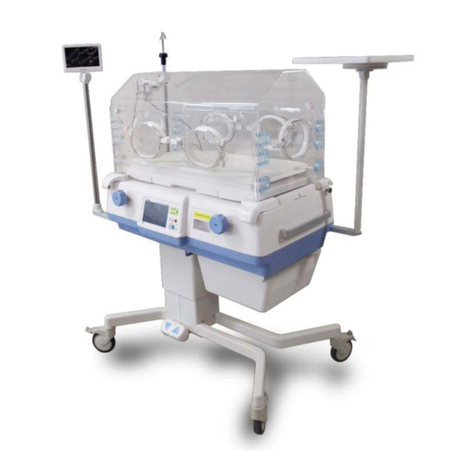
Bistos
Bistos BT-500 User manual
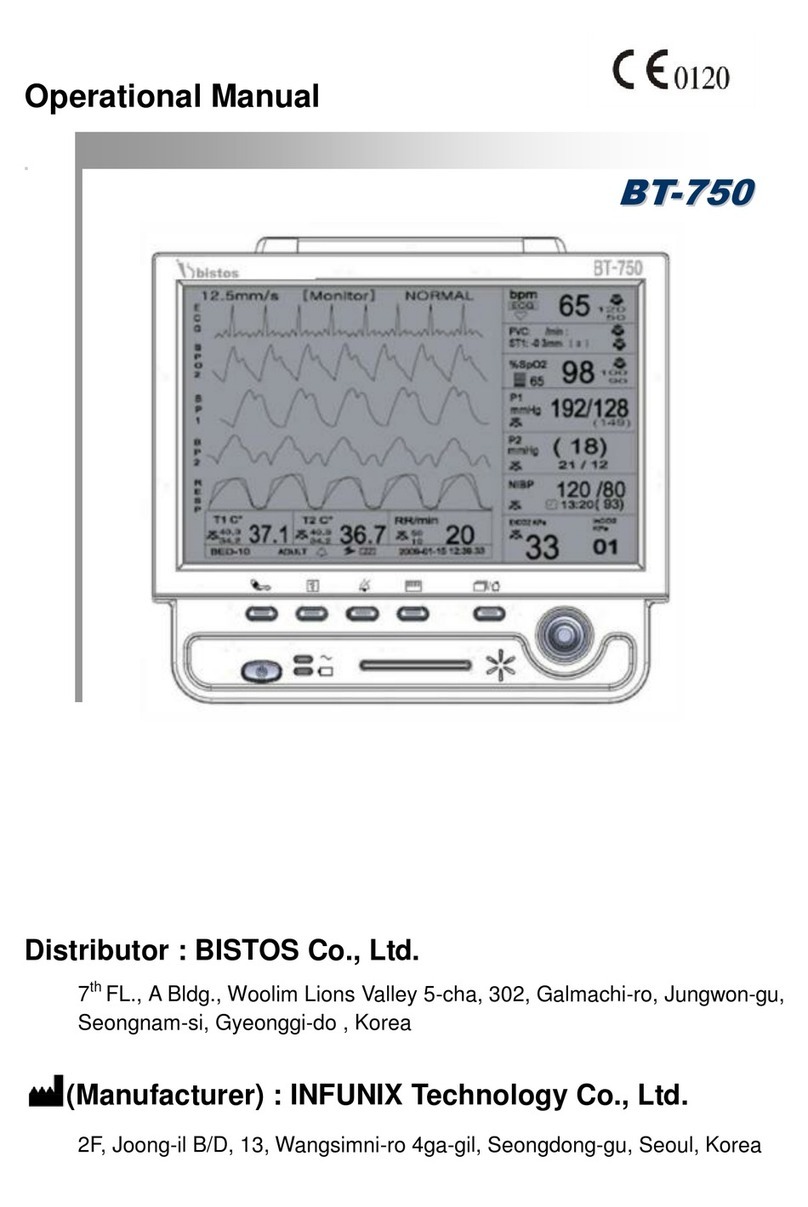
Bistos
Bistos BT-750 User manual

Bistos
Bistos BT-500 User manual
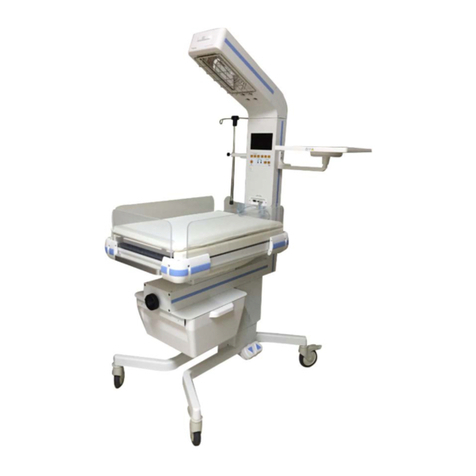
Bistos
Bistos BT-550 User manual
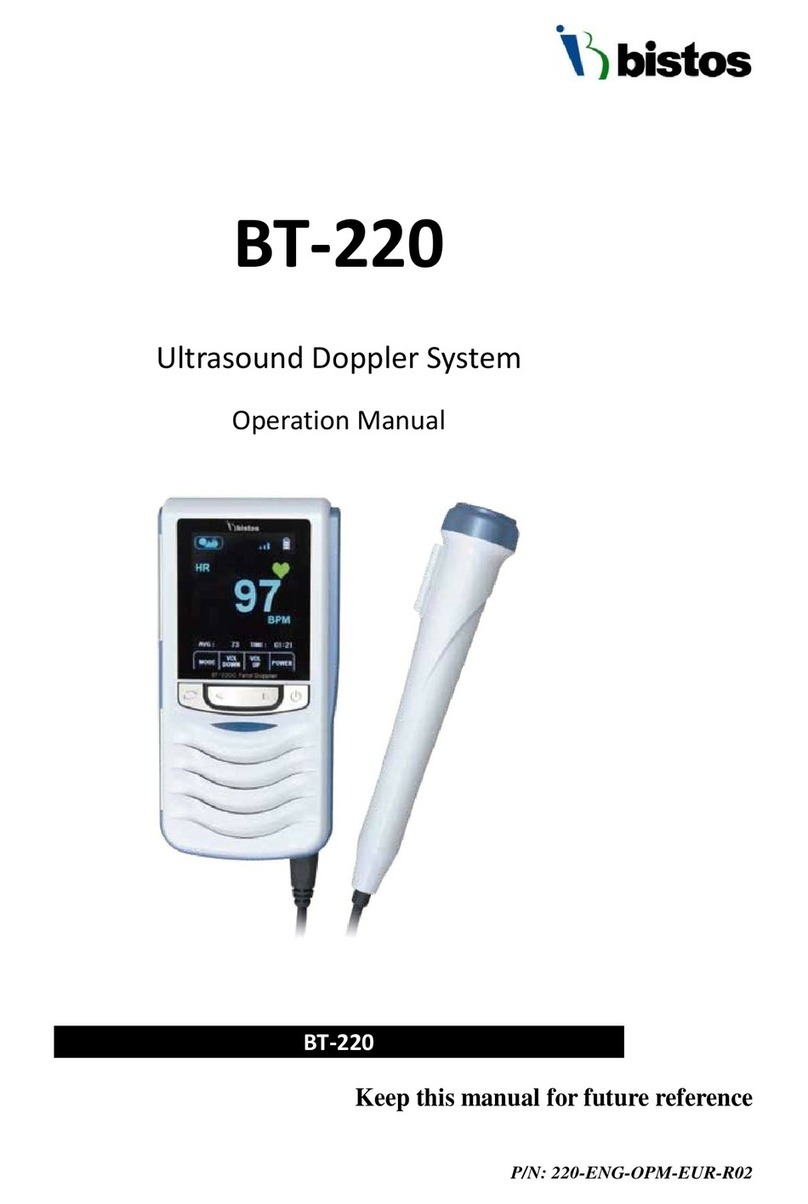
Bistos
Bistos BT-220 User manual

Bistos
Bistos BT-350 User manual
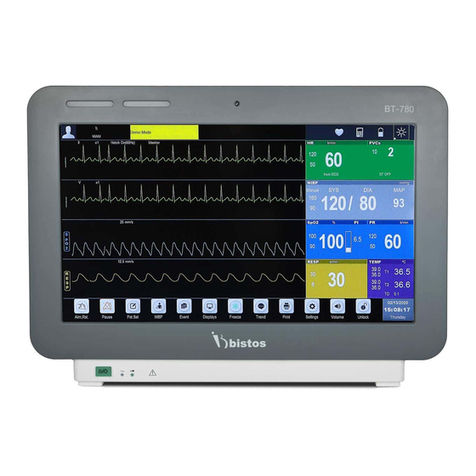
Bistos
Bistos BT-780 User manual
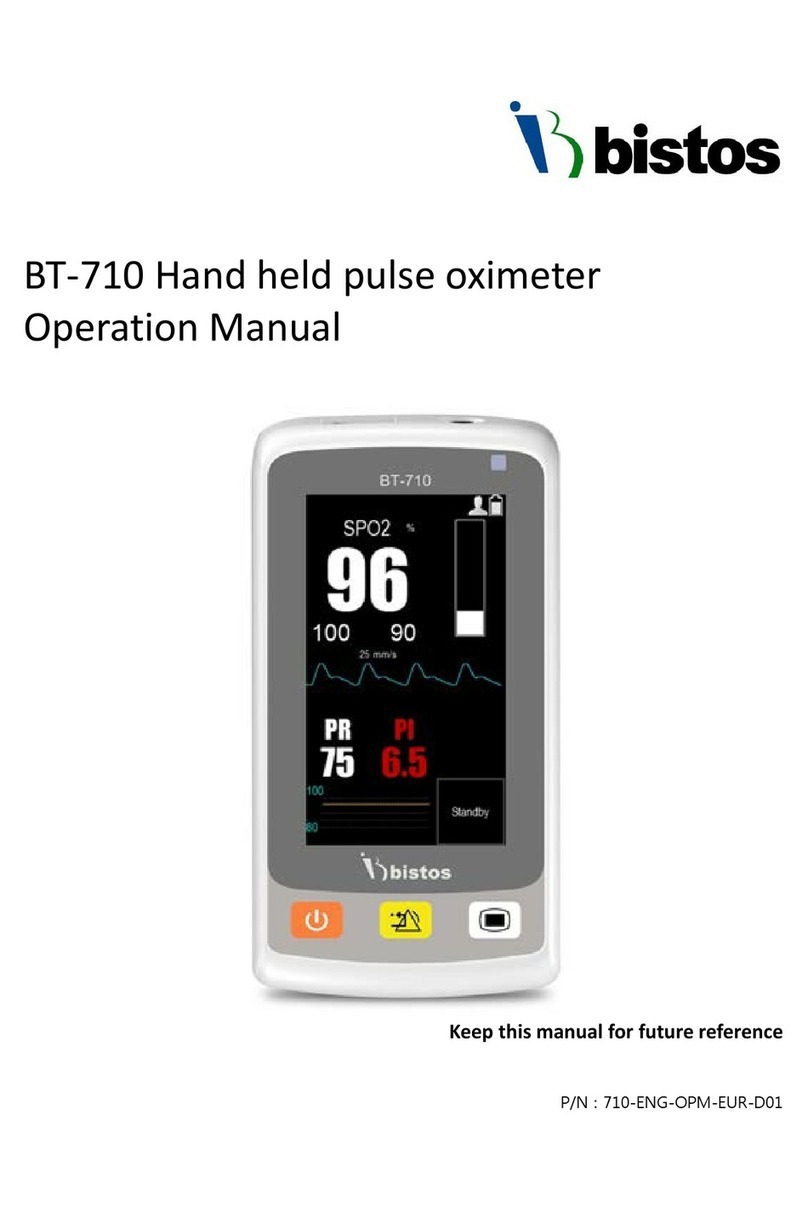
Bistos
Bistos BT-710 User manual
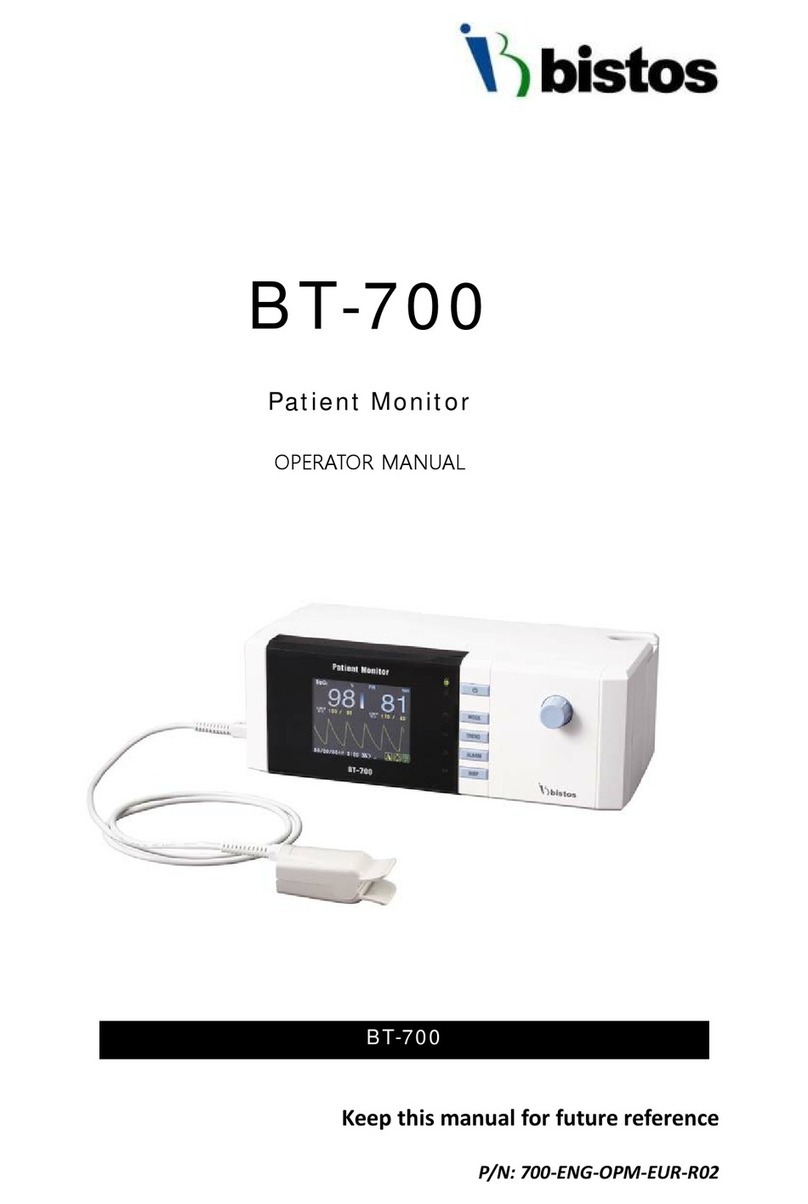
Bistos
Bistos BT-700 User manual

Bistos
Bistos BT-710 User manual
Popular Medical Equipment manuals by other brands
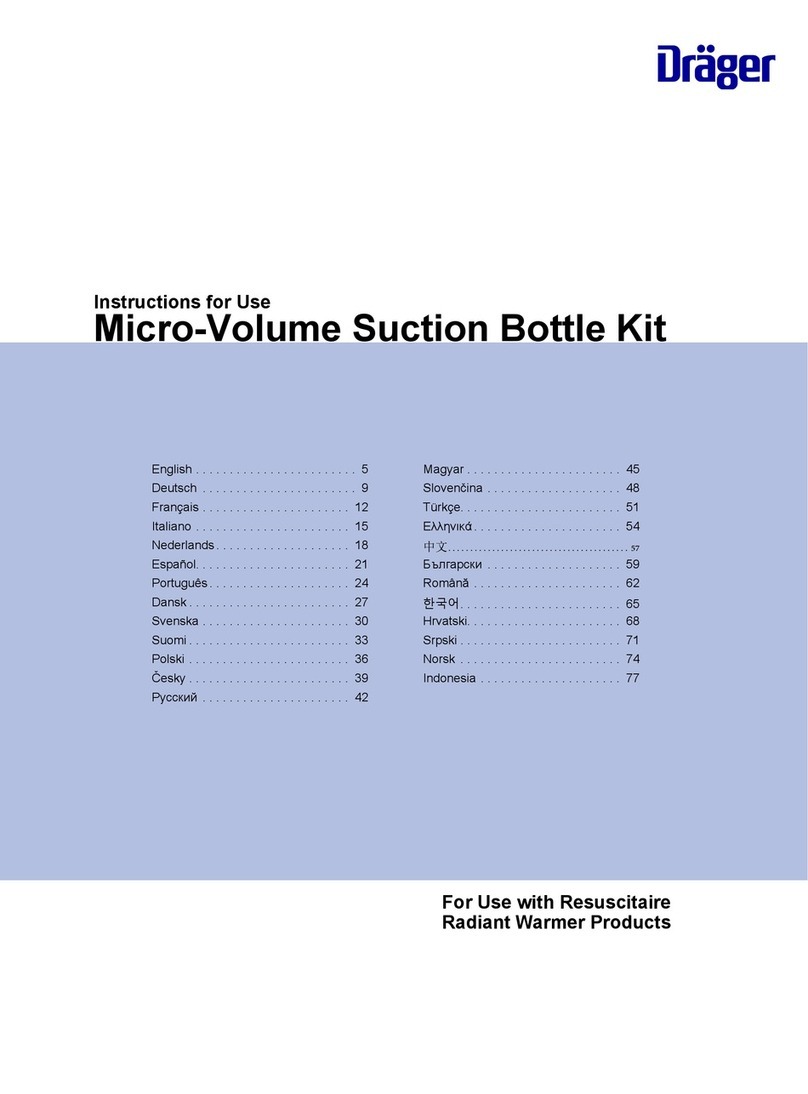
Dräger
Dräger MU10916 Instructions for use

ThermoTek
ThermoTek Artek PRO Instructions for use
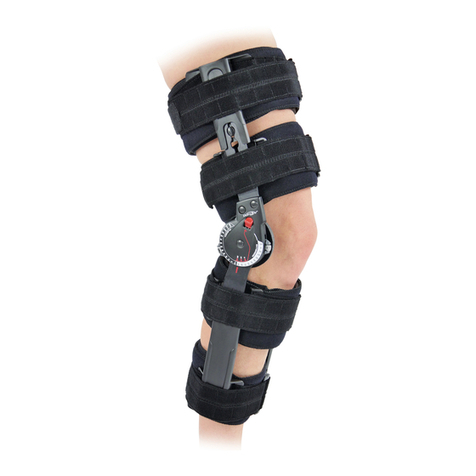
Donjoy
Donjoy X-Act ROM Lite Application Instructions
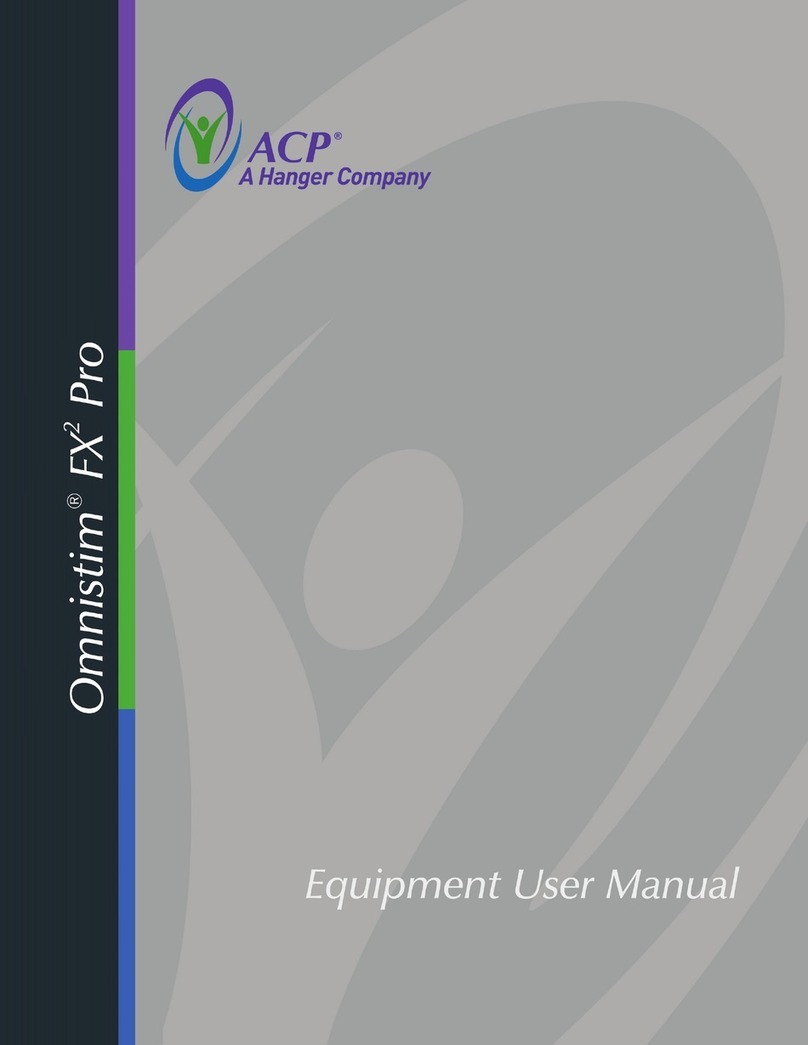
Accelerated Care Plus
Accelerated Care Plus OMNISTIM FX2 PRO user manual
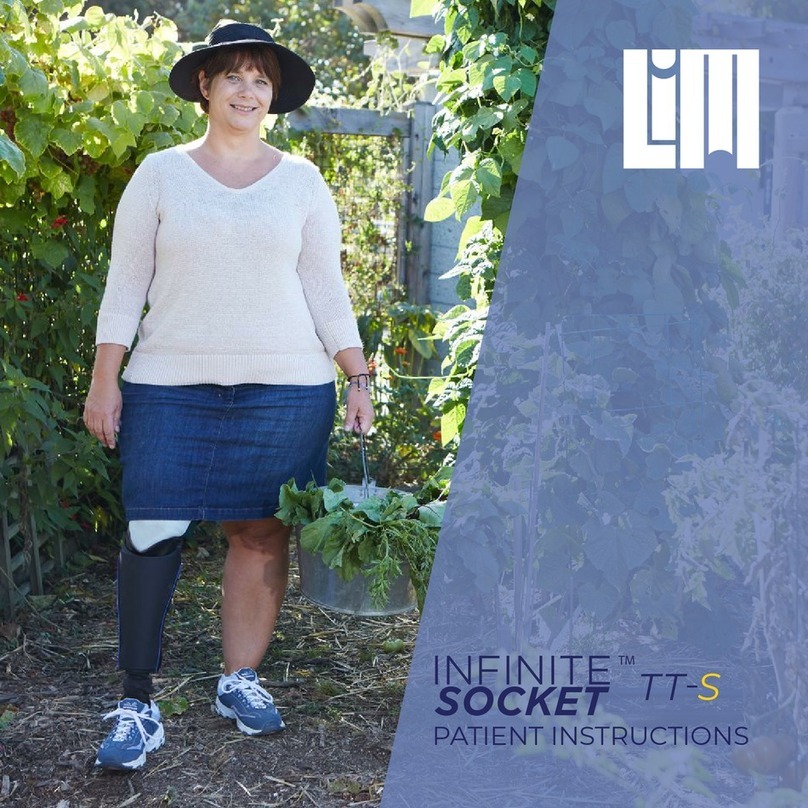
LIM
LIM INFINITE SOCKET TT-S Patient Instructions For Use
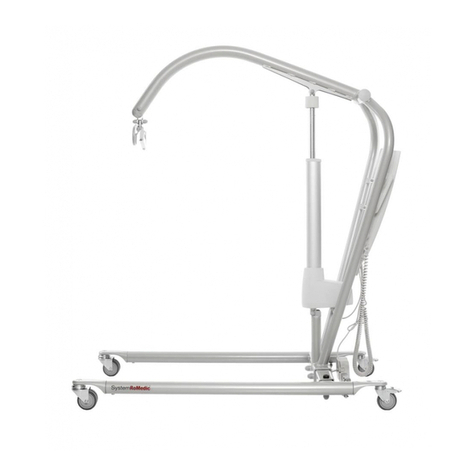
Handicare
Handicare SystemRoMedic Vega505EE user manual
